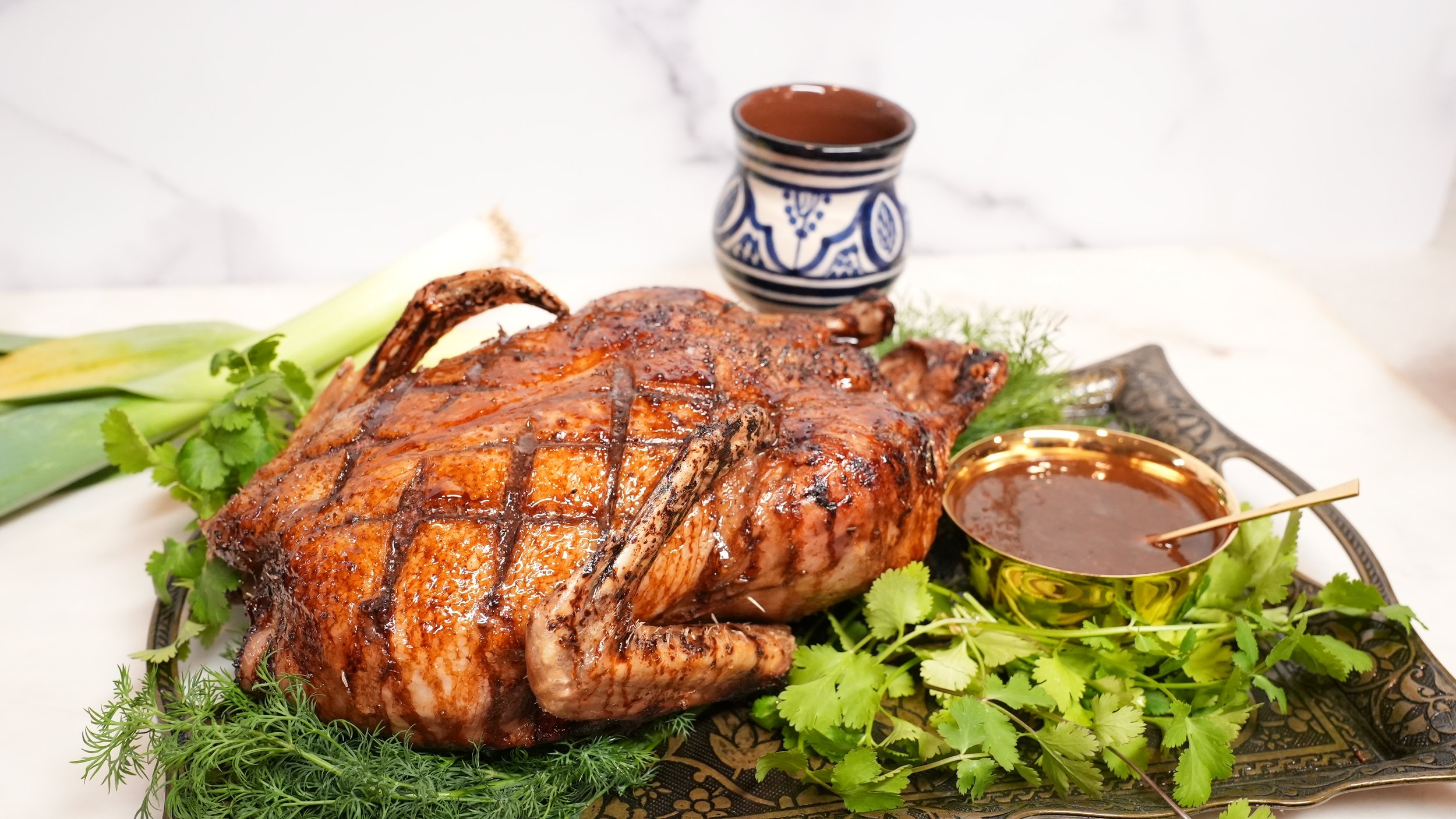Ancient Roman Flamingo (Duck)
Roast duck basted with defrutum and served with a sweet and savory dipping sauce atop a bed of herbs
City/Region: Rome
Time Period: 1st Century
First off, this is not a flamingo. While they’re still eaten in some parts of the world, where I live is not one of those parts. I’m using a duck instead, and it’s absolutely delicious.
The real star of this dish is the sauce, which I think would go well with pretty much anything. It’s sweet at first, then you get the savoriness and complexity of the herbs and spices along with a luxurious richness from the duck drippings. It might just be my favorite Roman sauce that I’ve made (and I’ve made quite a few).
“For flamingo:
Pluck the flamingo wash, tie, and put it in a pot; add water, salt, dill, and a little vinegar. Half-way through cooking, add a bundle of leek and cilantro and cook. When it is nearly done add defrutum to give it color. Pound in a mortar pepper, cumin, coriander, silphium, mint, rue; moisten with vinegar, add dates, pour over some of the drippings. Put it in the pot, thicken with starch, pour the sauce over the bird, and serve. The same recipe can be used for parrot.”
Ingredients:
Duck
- 2 tablespoons salt
- 1 small bunch of dill, tied together for easier removal
- 1/4 cup (60 ml) white wine vinegar
- 1 duck or goose, I used duck
- 2 leeks
- 1 small bunch of cilantro
- 3 tablespoons defrutum or sapa/saba*
Sauce
- 10-12 fresh mint leaves, finely minced
- 1 tablespoon rue*, fresh or dried, finely minced
- 2 teaspoons whole black peppercorns
- 2 teaspoons whole coriander seed
- 1 teaspoon cumin
- 1 cup finely chopped dates
- 1/2 teaspoon asafoetida*
- 2 teaspoons white wine vinegar
- Wheat starch**, if your sauce needs thickening (mine didn’t)
*See notes below.
**You can use cornstarch if you don’t have wheat starch. It’ll do the same job, it just isn’t as historically accurate.
Instructions:
- For the duck: Fill a pot large enough for your bird with water. Add the salt, the 1/4 cup (60 ml) of vinegar, and the dill. Bring the pot to a boil. Add the duck and boil for 15 minutes to partially cook it.
- To clean the leeks, slice them in half lengthwise and then slice the whites into half circles. Place the slices into a bowl of water and swish it around until any sand trapped inside the leeks has fallen to the bottom of the bowl.
- Preheat the oven to 350°F (175°C).
- After the duck has boiled for 15 minutes, take the pot off the heat and carefully transfer the duck to a baking dish breast side up. Stuff the cavity with the cleaned whites of the leeks and the cilantro. Truss the legs with some cooking twine. With a sharp knife, make a crosshatch pattern over each breast. You want to slice far enough to get into the fat, but not so far as to get into the meat. Poke holes into any other fatty parts of the duck. This will allow the fat to render out and create a crispy skin.
- Roast the duck for 30 minutes, then take it out and baste it with the defrutum.
- Return the duck to the oven and roast for another 30 to 45 minutes, or until it hits a temperature of 165°F (74°C) in the thickest part of the breast and the innermost part of the thigh. Take the duck out of the oven and set it aside to rest while you make the sauce.
- For the sauce: In a mortar and pestle, grind the peppercorns and the coriander seed. Mix with the cumin. Set aside.
- Grind the chopped dates in the mortar and pestle until you get a fine paste. Add the minced herbs, spice mixture, and asafoetida. Grind all of this together until it’s evenly mixed and the mixture is as smooth as you can get it. Add the 2 teaspoons of white wine vinegar and mix it in.
- Transfer the mixture into a small saucepan. Add the drippings and defrutum from the roasting dish and whisk everything together.
- Put the saucepan over medium heat and bring it to a simmer. Simmer for 5 minutes, stirring occasionally. If the sauce isn’t as thick as you’d like it, add some wheat starch and cook for another minute or two.
- You can serve the duck forth with the sauce poured over it or with the sauce on the side, whichever you prefer.
Notes
- Defrutum was a 1/3 reduction of grape must and is sweet and delicious. Today sapa/saba is pretty much the same thing. It can be expensive, so you can reduce some grape juice instead. It won't be as complex as saba, but it will work just fine.
- Rue is a bitter herb that was used in a lot of historical recipes. It's mildly toxic and should only be consumed in very small amounts, if at all. Do not eat rue if you are pregnant!
- Asafoetida, or hing, was Rome’s pungent replacement for their beloved silphium and imparts a wonderful garlicky umami flavor when cooked. Be sure to store it in a sealed container (or two) or your whole pantry will smell sulphurous. You can find it at Indian markets or at the link below.
- Defrutum/sapa/saba - https://amzn.to/3JGkbyK
- Rue - https://amzn.to/3DRpw7I
- Asafoetida - https://amzn.to/4l52uuE
Some links on this site are affiliate links. If you buy something through them, it does not cost you anything more, but we will get a small commission which helps keep the site up and running. Thanks!


